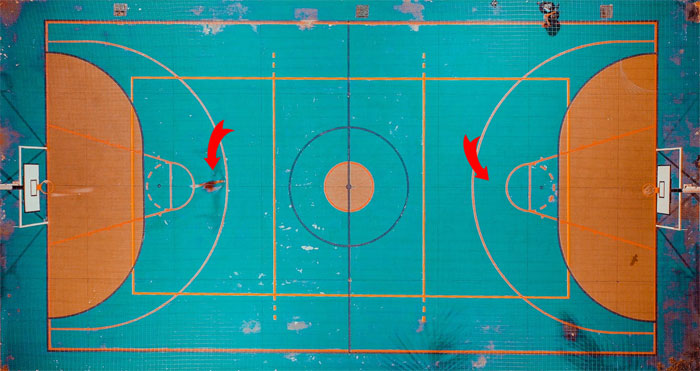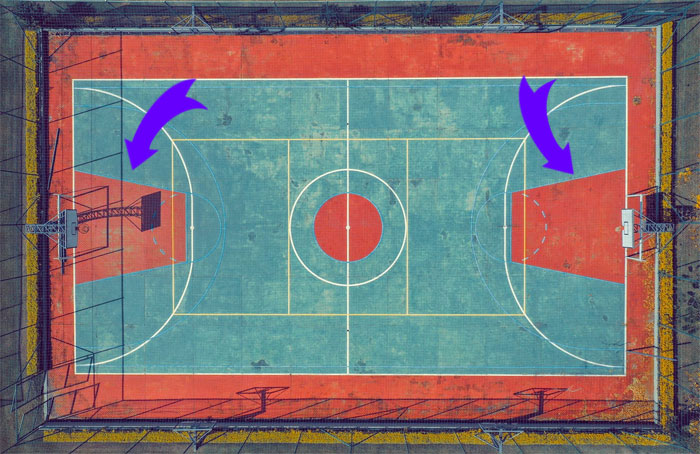We know the key under numerous names in basketball, although they all relate to the painted region behind the basket. Now let’s get an insight into this sports term’s history, rules, and regulations.
What Is the Top of the Key?
It is the space just directly in front of the three-point line and just past the free-throw line. Because the top of the key is a favorite shooting area, it's usual for zone defenses to cover it.

What Is the Key in Basketball?
The key is the section of the court extending from the free-throw line all to the baseline. The baseline is the border line that runs along the edge of the basketball court. It spreads behind the backboard of the shooting hoop or ring, determining when a ball is out of bounds.

Bordering the key are sidelines that mark the boundaries of the court; they typically feature a color different from the remainder of the court. Defensive players get three-second violations within the paint (the key) if they stay there for longer.
How Important Is the Key?
Just like one of those government facilities, we could say the key is a restricted area. The reason for this is its proximity to the basket. So, whenever a player enters this zone, they are already in a good position to score.
Origin of the Key
The name of the key derives from its original shape. In the past, it was a six-foot-wide lane in the free-throw circle. Hence, it resembled a key used for locks or doors. However, tall basketball players could dominate the game due to those dimensions.
In 1951, the NBA resized the key from six to twelve feet. Also, the league later added a foot in 1964 for a total width of sixteen feet. Again, this was due to leveling the playing field against some powerful centers.
Size of the Key
The basketball court has undergone many changes throughout the history of sports. The sizing and the dimensions up to the peak changed as well as the key’s radius and semicircle. The primary focus of the key was much more extensive than what it appears to be like today.
Today, the extent of play defines the dimension and shape of the key. Different leagues have different key dimensions. For instance, the NBA’s key is sixteen-foot-wide and nineteen-foot-wide from the baseline to the free throw line. It is rectangular, while the semi-circle at the top has a radius of six feet.
The NCAA and National Association of Intercollegiate Athletics (NAIA) use a twelve-foot, rectangular key. That shape runs nineteen feet from the baseline to the free-throw line. FIBA keys used to be trapezoids until 2010, when FIBA adopted a rectangular design. So, there is still no standard on how large the key should be.
What Part of the Court Is the Top of the Key Located?
The top of the key is above the top-most point of the free-throw circle. This is a twelve-foot circle cut by the free-throw line. It ends with the high post below the half-court line at both corners.
The three-point line usually extends from either side of the top of the key. It is a perfect area to call offensive plays due to its mid-court location. It seats in the frontcourt or the offense’s basket (the backcourt houses the defense’s basket).
Once the point guard brings up the ball to the top of the key, the offense can balance the court. Then, the team sends offensive players to both the strong side of the court (the side with the ball handler) and the weak side.
Even though point guards frequently call plays from the top of the key, it is an excellent spot for a field goal or three-point shot. On the other hand, the top of the key is the farthest point from the hoop for a two-point shot. As per statistics, three-point shots from the corner are more successful than two-point shots from the key.
Half-court games also start at the top of the key. Half-court games do not use a jump ball to determine ball possession, unlike full-court games. Instead, players on both sides begin the game by checking the ball.
The ball handler, or rather the individual in control of the ball, stands at the top of the semi-circle above the free-throw line. Next, they shout "Check,” before giving the ball to the other team's player who is protecting or guarding them.
When the player who is on defense passes the ball back to the offense, the ball is inbounds, and the game begins.
What Is a Three-Second Violation?
A three-second violation, often known as a “lane violation” or “three in the key,” is a common foul in basketball. As the name implies, it is a ruling against a basketball player who stays within the key for more than three seconds. Usually, this occurs when one player tries moving past a big center.
We divide the three-second rule into two types:
1. Defensive three-second violation - many often refer to this as an illegal defense. A defensive three-second violation is a technical foul to a team. It happens when a defensive player spends more than three seconds in the key while not guarding an opponent.
Due to this foul, the offense receives a free throw and control of the ball, as stipulated in the NBA regulations rulebook. The defensive three-second rule makes zone defense difficult to implement. So, defensive players should keep this in mind at all times. The defensive three-second violation doesn’t apply to FIBA or high school basketball games.
2. Offensive three-second violation - The variation of the offensive three-second violation is quite comparable to the defensive three-second variation. This foul will be on an offensive player who lingers in the key for too long. All the while, their team has the ball but struggles to find an opening.
A similar example is when they pass or dribble out of the lane. The offensive three-second violation is intended to prohibit offensive players from loitering or lingering at the low post. At the same time, the shot clock runs, allowing for total rebounding, blocking, and layup opportunities.
Top of the Key Strategies
Nowadays, players often choose not to take too many shots from the top of the key compared to before. This is because those tend to be on the riskier side. Plus, it is the farthest distance from the basket of all the two-pointer attempts. Hence, it’s wiser to go for a three-pointer since the distance from the basket is only slightly longer.
About only 86 points out of a hundred attempts are results of shots from the top of the key. That is well below the national average for corner three-pointers which stands at 119 points per hundred possessions. As that is the case, basketball coaches today advise for a different approach.
However, this does not mean that these shots are nowhere to be found in modern times. These positions still help set up plays and give players a reference point while spacing themselves out on the court.
Frequently Asked Questions (FAQs)
1. Is it possible to avoid a three-second violation?
Yes, you can avoid it as long as you exit the key area within the three-second limit, and this timer resets upon re-entering.
2. Are you only limited to three seconds?
It varies from time to time. The referee has the option of issuing a warning first. Also, they won't always have enough time to count because they're officiating the game's start. As a result, a player might escape with a one or two-second head start.
3. Is it possible to have one foot in the key and one foot out?
Generally, that is also considered the same as standing within the key.
4. Is there a three-second timer reset after a shot?
Yes, after each shooting attempt, the three-second timer resets as long as the player shoots at the basket.
Conclusion
As evident, the top of the key is a historically important part of basketball, relevant even today. We can see how this dimensional space on the court has evolved through time by looking at the key's origin.
Throughout the years, the dimensions changed and impacted how teams approach related situations. The size of the key also varies in different leagues.
As a result, there are different rules and regulations that govern this top-of-the-key area in basketball. To accommodate, coaches develop many strategies to navigate this zone better. In turn, the rulebooks change further still, adding new types of violations to preserve the game’s fairness.
Today, the top of the key remains a crucial area where many pro-moves take place. Basketball superstars often aim to utilize this part of the field, thus avoiding the mess forming around the basket. So, they circumvent the other team’s expectations by mastering scoring a two-pointer from this unusual distance.
